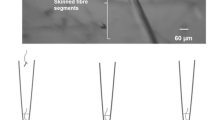Abstract
A fast breakdown of glycogen is observed in muscles of stress-susceptible pigs leading to pale, soft and exudative (PSE) meat. We report a comparative study of pyruvate kinase from muscles of normal and PSE-prone pigs. Compared with the enzyme from normal muscle, pyruvate kinase isolated from PSE muscle shows a five times lower Michaelis constant,K m, for phosphoenol pyruvate and a more than ten times higherk cat/K m value. The pH dependency of the enzymatic activity is shifted to more acidic values for pyruvate kinase from PSE muscles. According to isoelectric focusing, pyruvate kinase from PSE muscle consists of three isoforms, while only two isoforms are detectable in pyruvate kinase preparations from normal pigs. The various isoforms were isolated by preparative isoelectric focusing and their steady-state properties were compared. Isoform 3, which is found only in PSE muscle, shows a 10-fold higher specific activity, a 30-fold lowerK m value and a 100-fold increasedk cat/K m value for phosphoenol pyruvate as compared to isoform 1. The presence of isoform 3 in PSE muscle appears to be responsible for the high activity of this enzyme under the more acidic conditions prevailing in PSE muscle. In vitro phosphorylation and dephosphorylation experiments using total enzyme and purified isoenzyme 1 suggest that isoforms 2 and 3 arise from isoform 1 by phosphorylation. Thus protein phosphorylation seems to be responsible for the shift in activity of pyruvate kinase, a key enzyme of glycolysis, under the acidic conditions of PSE muscles.
Similar content being viewed by others
References
Briskey EJ (1964) Adv Food Res 13: 89–178
Briskey EJ, Kastenschmidt LL, Forrest JC, Beecher CR, Judge MD, Cassens RG, Hoekstra WG (1966) J Argic Food Chem 14: 21–31
Bendall JR, Wismer-Pedersen J (1962) J Food Sci 27: 144–159
Schwägele F, Lopez P, Haschke C, Honikel KO (1994) Fleischwirtschaft 74: 95–101
Altrogge DM, Topel DG, Cooper MA, Hallberg JH, Drapper DD (1980) J Anim Sci 51: 74–77
Rock E, Kozat-Reiss G (1987) Arch Biochem Biophys 256: 703–707
Kim DH, Sreter FA, Tsuyoshi Onishi S, Ryan JF, Roberts J, Allen PD, Meszaros LG, Antoniu B, Ikemoto N (1984) Biochim Biophys Acta 775: 320–327
Fill M, Coronado R, Mickelson JR, Vilveen J, Ma J, Jacobson BA, Louis CF (1990) Biophys J 57: 471–475
Clark MG, Williams CH, Pfeifer WF, Bloxham DP, Holland PC, Taylor CA, Lardy HA (1973) Nature 245: 99–101
Cheah KS, Cheah AM (1981) Biochim Biophys Acta 634: 70–84
Cheah KS (1984) Biochem Soc Trans 12: 358–360
Cheah KS, Cheah AM, Waring JC (1986) Meat Sci 17: 37–53
Eikelenboom G, van den Bergh SG (1973) J Anim Sci 37: 692–696
Schwägele F, Honikel KO (1989) In: Hofmann JG, Schmidt A (eds) Malignant hyperthermia an update. Verlag Volk und Gesundheit, Berlin, pp 307–311
Fischer K, Augustini C, Festerling A, Schmitten F (1987) Züchtungskunde 59: 51–62
Scopes RK (1977) Biochem J 161: 265–277
Scopes RK (1977) Biochem J 161: 253–263
Laemmli UK (1970) Nature 227: 680–685
Rodbard D, Chrambach A (1974) In: Allen RC, Maurer HR (eds) Electrophoresis and isoelectric focusing in polyacrylamide gel. Walter de Gruyter, Berlin, pp 28–61
Frey MD, Kinzhofer A, Atta BM, Radola BJ (1986) Electrophoresis 7: 28–40
Pharmacia LKB (1989) In: 2117 Multiphor II electrophoresis system. Pharmacia LKB, Uppsala, Sweden, pp 87–96
Hjelmquist G, Andersson J, Edlund B, Engström L (1974) Biochem Biophys Res Commun. 2: 559–563
Barman TE (1969) Enzyme Handbook I and II. Springer, Berlin Heidelberg New York
Ashizawa K, McPhie P, Lin KH, Cheng SY (1991) Biochemistry 30: 7105–7111
Rijksen G, Van der Heijden MCM, Oskam R, Staal GEJ (1988) FEBS Lett 233: 69–73
Kutzbach K, Bischofberger H, Hess B, Zimmermann-Telschow H (1973) Hoppe-Seylers Z Physiol Chem 354: 1473–1489
Kiffmeyer WR, Farrar WW (1991) J Prot Chem 10: 585–591
Berglund L, Ljungstrom O, Engstrom L (1977) J Biol Chem 252: 6108–6111
Engstrom L, Berglund L, Bergstrom G, Hjelmquist G, Ljungstrom O (1974) In: Richter D (ed) Lipman Symposium: Energy, regulation and biosynthesis in molecular biology. de Gruyter, Berlin, Germany, pp 192–204
Matsuura R, Tanigawa Y, Tsuchiya M, Mishima K, Yoshimura Y, Shimoyama M (1988) Biochim Biophys Acta 969: 57–75
Oude W, Paschal A, Rijksen G, Mascini EM, Gerard EJ (1992) Biochim Biophys Acta 1121: 61–68
Hoar CG, Nicoll GW, Schiltz E, Schmitt W, Bloxham DP, Byford MF, Dunbar B, Fothergill LA (1984) FEBS Lett 171: 293–296
Author information
Authors and Affiliations
Rights and permissions
About this article
Cite this article
Schwägele, F., Haschke, C., Krauss, G. et al. Comparative studies of pyruvate kinase from PSE and normal pig muscles. Z Lebensm Unters Forch 203, 14–20 (1996). https://doi.org/10.1007/BF01267763
Received:
Revised:
Issue Date:
DOI: https://doi.org/10.1007/BF01267763



